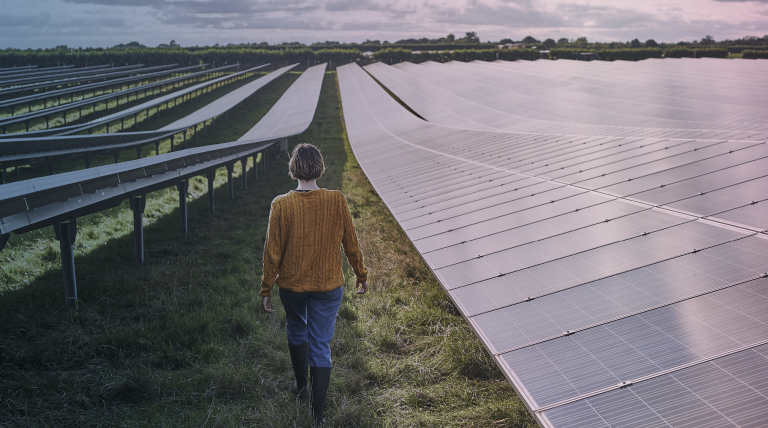For 40 years, we've been driving our country's economic and social progress. Four decades shaping Spain.
Red Eléctrica and Enagás will use Herding to Control Vegetation in High-Voltage Electricity and Gas Infrastructures in Alto Bernesga
- Two shepherdesses and their herds of cattle and horses will keep 17 hectares of the biosphere reserve which are crossed by a Red Eléctrica line and an Enagás line.
- Recurrent herding has proven to be the most sustainable alternative to the usual logging and pruning due to its highly positive impact on the environment and the community.
- The project is open to other companies, administrations, cattle exploitations and shepherd schools to be replicated in natural spaces affected by infrastructures.
Two cattle and horse herds guided by two shepherdesses are now in charge of keeping under control the vegetation of 17 hectares of the Alto Bernesga Biosphere Reserve (León) which are crossed by a Red Eléctrica de España line and an Enagás pipelines.
Due to a collaboration agreement with the environmental company Agrovidar, Red Eléctrica and Enagás will replace the usual logging and pruning work that are used there to control biomass with extensive livestock farming.
The work under the Red Eléctrica line, within the municipality of Villamanín, specifically Casares de Arbas, will be performed by 80 Asturiana de los Montes cows. The work related to the soil over the Enagás pipelines in Folledo, La Pola de Gordón, will be performed by 44 mares and one horse of the Hispano-Bretón breed. In both cases, these are breeds that are recognised by the Junta of Castile and León as indigenous and are owned and herded by women.
“We are committed to being a company that not only goes through the territory but stays in it working jointly with its people to improve their quality of life and natural capital, weaving networks of life that lead to opportunities and revitalise the rural environment”, explained today Juan Ávila, Head of Social Innovation of the Red Eléctrica Group, in the framework of the sessions celebrated in La Pola de Gordón to present the project.
Meanwhile, Enagás collaborates in this initiative “that helps maintain the areas traversed by out infrastructures in adequate conditions while preserving the ecosystems and their biodiversity, and aiding the development of the local herding activity in areas such as the Alto Bernesga Biosphere Reserve”, commented Elena Blanco, Head of Sustainability & Environment at Enagás.
In connection to this, the mayoress of La Pola, Noemí González, said: “We know that in order to supply the demand of all territories, we cannot avoid power lines and gas pipelines passing through rural areas.
Therefore, we are thankful for the initiative because it makes the general interest compatible with the existence of our villages: it respects the territory, reduces the carbon footprint and supports an economic sector, extensive herding, which has always been important in the region, even more so with the closure of the mines”.
For her part, Beni Rodríguez, Manager of the Alto Bernesga Biosphere Reserve highlighted the research, innovation and knowledge transfer aspects of the project, which turn the reserve into a work and experimentation laboratory that can be replicated in other territories that are crossed by infrastructures.
A Nature-Based Solution with a Digital and Technological Component
The streets that run under power lines or over gas pipelines must be clean and accessible for proper maintenance and operation. To avoid trees generating safety problems by intercepting the cables or their roots penetrating the subsoil and reaching underground pipelines, recurrent herding has proven to be the most sustainable solution due to its highly positive impact on the environment and the community.
On the one hand, it brings additional income for livestock farmers and provides them with an area to graze their livestock; on the other hand, the clearing is more efficient. But above all, the animals carry out a fertilising and trampling task that has a favourable impact on the flora and fauna, increasing biodiversity, as shown by a study performed by the University of Alcalá de Henares on the initiative. For this reason, the International Union for Conservation of Nature (IUCN) is assessing its categorisation as a nature-based solution.
Additionally, the project brings digitisation and technology to the livestock sector since it incorporates the use of drones and GPS collars. Drone flights, geographic information systems and tele detection facilitate the management and coordination of the clearing work, while the application of GPS devices on some cattle individuals shows in full detail where they are located and how long they stay in each area.
The León initiative was inspired by “Pastoreo en RED”, the project carried out by Red Eléctrica in Calahorra (La Rioja), where a herd of 400 sheep is maintaining the vegetation under the power line that goes through the Los Agudos hills. A pioneer in Europe, the project garnered a special mention in the 2021 Good Practice Awards of the European Renewables Grid Initiative platform.
To extend this practice, Red Eléctrica will be open to collaborations with autonomous communities, town councils, shepherds' schools, breeders' associations and other companies interested in similar projects. Likewise, it has published a guide for them to take advantage of the knowledge and methodologies acquired in La Rioja.
In the case of Enagás, the company has been working since 2016 on a similar project in the province of Huesca. Specifically, this programme achieves vegetation control by means of extensive livestock management along the pipelines located in the province of Huesca that are attached to the Caspe and Sabiñánigo Transmission Centres. The results obtained in these years have been excellent, and have proven the effectiveness and the advantages of using livestock for tasks such as developing a layer of vegetation through the intervention of animals.












